
38
EnGLIsH
water. If liquid contacts eyes, additionally seek medical help.
Liquid ejected from the battery may cause irritation or burns.
e )
Do not use a battery pack or tool that is damaged or modified.
Damaged or modified batteries may exhibit unpredictable behaviour
resulting in fire, explosion or risk of injury.
f )
Do not expose a battery pack or tool to fire or excessive
temperature.
Exposure to fire or temperature above 130 °C may
cause explosion.
g )
Follow all charging instructions and do not charge the battery
pack or tool outside the temperature range specified in the
instructions.
Charging improperly or at temperatures outside the
specified range may damage the battery and increase the risk of fire.
6) Service
a )
Have your power tool serviced by a qualified repair person
using only identical replacement parts.
This will ensure that the
safety of the power tool is maintained.
b )
Never service damaged battery packs.
Service of battery packs
should only be performed by the manufacturer or authorized
service providers.
Safety Instructions for Mitre Saws
a )
Mitre saws are intended to cut wood or wood-like products,
they cannot be used with abrasive cut-off wheels for cutting
ferrous material such as bars, rods, studs, etc. Abrasive dust
causes moving parts such as the lower guard to jam.
Sparks from
abrasive cutting will burn the lower guard, the kerf insert and other
plastic parts.
b )
Use clamps to support the workpiece whenever possible. If
supporting the workpiece by hand, you must always keep your
hand at least 100 mm from either side of the saw blade. Do
not use this saw to cut pieces that are too small to be securely
clamped or held by hand.
If your hand is placed too close to the saw
blade, there is an increased risk of injury from blade contact.
c )
The workpiece must be stationary and clamped or held against
both the fence and the table. Do not feed the workpiece into
the blade or cut “freehand” in any way.
Unrestrained or moving
workpieces could be thrown at high speeds, causing injury.
d )
Push the saw through the workpiece. Do not pull the saw
through the workpiece. To make a cut, raise the saw head
and pull it out over the workpiece without cutting, start the
motor, press the saw head down and push the saw through
the workpiece.
Cutting on the pull stroke is likely to cause the saw
blade to climb on top of the workpiece and violently throw the blade
assembly towards the operator.
e )
Never cross your hand over the intended line of cutting either
in front or behind the saw blade.
Supporting the workpiece “cross
handed” i.e. holding the workpiece to the right of the saw blade with
your left hand or vice versa is very dangerous.
f )
Do not reach behind the fence with either hand closer than
100 mm from either side of the saw blade, to remove wood
scraps, or for any other reason while the blade is spinning.
The
proximity of the spinning saw blade to your hand may not be obvious
and you may be seriously injured.
g )
Inspect your workpiece before cutting. If the workpiece is
bowed or warped, clamp it with the outside bowed face toward
the fence. Always make certain that there is no gap between
the workpiece, fence and table along the line of the cut. Bent or
warped workpieces can twist or shift and may cause binding on
the spinning saw blade while cutting.
There should be no nails or
foreign objects in the workpiece.
h )
Do not use the saw until the table is clear of all tools, wood
scraps, etc., except for the workpiece.
Small debris or loose pieces
of wood or other objects that contact the revolving blade can be
thrown with high speed.
i )
Cut only one workpiece at a time.
Stacked multiple workpieces
cannot be adequately clamped or braced and may bind on the blade
or shift during cutting.
j )
Ensure the mitre saw is mounted or placed on a level, firm work
surface before use.
A level and firm work surface reduces the risk of
the mitre saw becoming unstable.
k )
Plan your work. Every time you change the bevel or mitre
angle setting, make sure the adjustable fence is set correctly
to support the workpiece and will not interfere with the blade
or the guarding system.
Without turning the tool “ON” and with
no workpiece on the table, move the saw blade through a complete
simulated cut to assure there will be no interference or danger of
cutting the fence.
l )
Provide adequate support such as table extensions, saw horses,
etc. for a workpiece that is wider or longer than the table top.
Workpieces longer or wider than the mitre saw table can tip if
not securely supported.
If the cut-off piece or workpiece tips, it can
lift the lower guard or be thrown by the spinning blade.
m )
Do not use another person as a substitute for a table extension
or as additional support.
Unstable support for the workpiece can
cause the blade to bind or the workpiece to shift during the cutting
operation pulling you and the helper into the spinning blade.
n )
The cut-off piece must not be jammed or pressed by any means
against the spinning saw blade.
If confined, i.e. using length
stops, the cut-off piece could get wedged against the blade and
thrown violently.
o )
Always use a clamp or a fixture designed to properly support
round material such as rods or tubing.
Rods have a tendency to
roll while being cut, causing the blade to “bite” and pull the work with
your hand into the blade.
p )
Let the blade reach full speed before contacting the workpiece.
This will reduce the risk of the workpiece being thrown.
q )
If the workpiece or blade becomes jammed, turn the mitre
saw off. Wait for all moving parts to stop and disconnect the
plug from the power source and/or remove the battery pack.
Then work to free the jammed material.
Continued sawing with
a jammed workpiece could cause loss of control or damage to the
mitre saw.
r )
After finishing the cut, release the switch, hold the saw head
down and wait for the blade to stop before removing the cut-off
piece.
Reaching with your hand near the coasting blade is dangerous.
s )
Hold the handle firmly when making an incomplete cut or when
releasing the switch before the saw head is completely in the
down position.
The braking action of the saw may cause the saw
head to be suddenly pulled downward, causing a risk of injury.
Additional Safety Rules for Mitre Saws
WARNING:
Do not insert the battery into the unit until complete
instructions are read and understood.
•
DO NOT OPERATE THIS MACHINE
until it is completely assembled and
installed according to the instructions. A machine incorrectly assembled
can cause serious injury.
•
OBTAIN ADVICE
from your supervisor, instructor, or another qualified
person if you are not thoroughly familiar with the operation of this
machine. Knowledge is safety.
•
MAKE CERTAIN
the blade rotates in the correct direction. The teeth on the
blade should point in the direction of rotation as marked on the saw.
•
TIGHTEN ALL CLAMP HANDLES,
knobs and levers prior to operation.
Loose clamps can cause parts or the workpiece to be thrown at
high speeds.
•
BE SURE
all blade and blade clamps are clean, recessed sides of blade
clamps are against blade and arbor screw is tightened securely. Loose or
improper blade clamping may result in damage to the saw and possible
personal injury.
Содержание DCS365
Страница 1: ...Final Page Size 172 x 240 mm DCS365 ...
Страница 4: ...2 Fig B Fig C Fig D Fig F1 Fig E 16 26 44 Fig F2 27 22 4 28 29 30 31 35 16 44 10 ...
Страница 5: ...3 Fig F3 Fig G1 Fig H Fig G2 Fig I 31 32 30 33 34 Fig G3 Fig G4 1 36 18 14 37 ...
Страница 6: ...4 Fig J Fig L1 Fig K Fig L2 Fig M Fig N Fig O Fig P 9 9 9 8 7 5 12 42 41 39 40 45º 48º 12 38 21 25 ...
Страница 7: ...5 Fig Q Fig R angle A A B Fig S Fig T Fig U Fig V 11 43 11 43 Fig W Fig X ...
















































